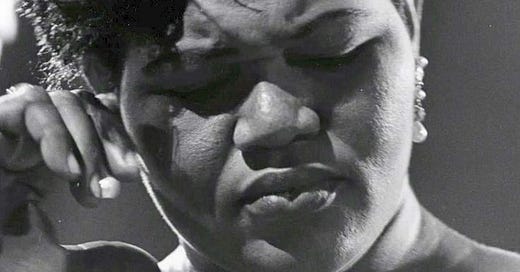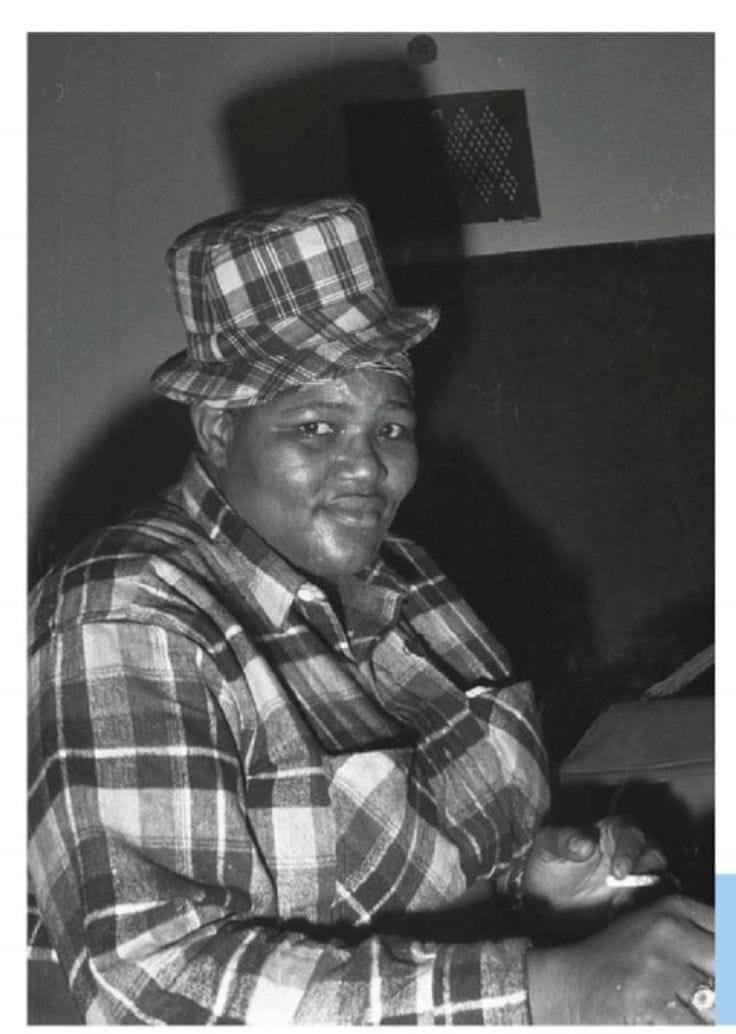The 1950s were an era of Civil Rights and McCarthyism. During it all two queer icons were creating genres on one label. At twenty-six years old and plus-sized, Big Mama Thornton walked on stage in denim overalls, and Little Richard was a flamboyant, skinny, dark-skinned man with long greasy hair. They were both performers at the Bronze Peacock Club in Houston, Texas. Both performers began at a young age, cross-dressing and learning theatrical skills on the road.
The 1920's political landscape was open to queer sexuality on the radio, but amid WW2 Black nationalist respectability emerged with deeply homophobic roots. Scholar Tyina Steptoe in the American Quarterly says, "Queerness can refer to gender performance as well as sexual desire and sexual practice." What was so queer about Little Richard and Big Mama Thorton's art?
Willie Mae Thornton was born in 1926 in Alabama. She got her start at 13 years old singing in taverns and within a year would join Sammy's Green's Hot Harlem Revue, a touring company based in Atlanta. Thornton began to be advertised as the next Bessie Smith, one of her idols. Willie Mae was not conventionally feminine. She would wear a tie and trousers with conked hair on stage with a fan behind her.
In NYC, as a Rhythm and Blues Caravan member, Willie Mae defied Johnny Otis's wishes regarding her attire at the Apollo Theater. After a heated exchange, Willie Mae put on the gown Otis gave her, but on stage, hiked it up to show her cowboy boots. Evelyn Johnson, the manager of Buffalo Booking Agency, promoted the Peacock artist and had issues with Willie Mae's dress. Johnson wanted Willie Mae to mimic the women in Jet and Essence magazines, but she protested with every fashion decision.
Richard Wayne Penniman was born in 1932 in Georgia and raised in the church. He performed in drag and was colloquially known as the king and queen of blues. Little Richard first dressed as a woman on stage in a traveling show called "Sugarfoot Sam from Alabam," where he played "Princess Lavonne." From there, he performed in a troupe called Tidy Jolly Steppers. Little Richard wrote his classic Tutti Frutti in a comedy troupe. The lyrics were "Tutti Frutti, good booty / If it doesn't fit, don't force it / You can grease it, make it easy."
In 1955, when the track was to be put on wax, music executives made Richard change the explicit reference to annul sex into "Tutti frutti, oh tutti." This decision was rooted in cultural norms of the time. Blues fans were freaky compared to white Christian audiences, so for Chitlin Circuit hits to go mainstream, they had to be sanitized. A year after Little Richard's radio cut was released, Elvis Presley stole his music and recut the record, earning double the residuals. 1956, Elvis also stole Willie Mae Thornton's 1952 song Hound Dog.
Thornton's most popular song Hound Dog is about her disgust with a male lover. Leiber and Stoller wrote the song for Willie Mae because "She looked like the biggest, baddest, saltiest chick you would ever see. And she was mean, a 'lady bear,' as they used to call 'em. She must have been 350 pounds, and she had all these scars all over her face. I had to write a song for her that basically said, 'Go fuck yourself'".
Johnny Otis is the one who gave Willie Mae Thornton the stage name of "Big Mama." The moniker is normatively feminine in a way that Thornton was not. The mamie label was used to de-radicalize Thornton's queer lifestyle. Thornton was young yet perceived as an older, authoritative figure. This juxtaposition was an intentional PR tactic. This marketing strategy was successful in the case of Ma Rainey as well.
In 1930's Houston Jim Crow was strong, yet there still was a growing gig economy for Negro musicians. The city was coined "Bayou City." The Third, Fourth, and Fifth Wards had thriving entertainment districts. Big Mama Thornton and Little Richard were both signed briefly by Peacock Records in the early 1950s, and despite the label's Black ownership, they both felt they were not paid appropriately.
Don Robey, the head of Peacock Records, physically and financially abused his employees. Little Richard was assaulted by Robey and would suffer from a severe hernia for several years. Robey did not renew Thornton's contract in 1956 because he could not physically threaten her. Robey was frightened by Thornton's physical prowess.
Little Richard intentionally dressed his band in a gay fashion to combat stereotypes associated with Black masculinity. His all black male band was navigating a political environment that was obsessed with the notion of black masculinity endangering white femininity. Little Richard dressed his band as queer as himself to withstand the backlash. A group of Black sissies were not interested in seducing crowds of white women merely entertaining them. Gayness was used as a persona to protect the band from white supermacys' wrath.
Big Mama Thornton's slick suits and Little Richard's sparkly jumpsuits created the aesthetic foundation for Michael Jackson and Prince. Both these artists were out and proud while topping the charts, speaking to a pop, queer, and southern audience. Little Richard would pivot from sound to sound. Becoming a gospel artist in 1957, then transitioning to rock n roll in 1962.
Gender nonconformity in the 1950’s was perceived as a sign of psychological immaturity. Homosexuality was viewed as a form of sexual deviance as opposed to a difference in lifestyle. In contrast Black queerness was a noticeable and popular aspect of blues recordings in the early twentieth century. Fairies were all over the charts and were still being stolen from. No era was ever entirely safe.
Legends are legends across time and definition. The backlash has a different shape every time.
Willie Mae Thornton in Stockholm, October 9, 1965
Little Richard in 1971
Willie Mae Thornton in London 1965
Steptoe, Tyina. "Big Mama Thornton, Little Richard, and the Queer Roots of Rock'n'Roll." American Quarterly 70.1 (2018): 55-77.






